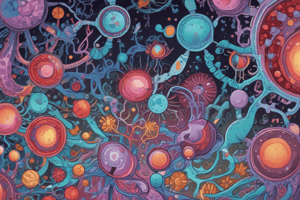Podcast
Questions and Answers
What is the primary function of normal microbiota in the human body?
What is the primary function of normal microbiota in the human body?
- Occupying niches that pathogens might occupy (correct)
- Producing toxins
- Stimulating the immune system
- Causing disease
Which of the following is a requirement for establishing causality of an infectious disease according to Koch's postulates?
Which of the following is a requirement for establishing causality of an infectious disease according to Koch's postulates?
- Isolation of the pathogen from a healthy individual
- Demonstration of the pathogen's presence in every case of the disease (correct)
- Development of a vaccine against the pathogen
- Growth of the pathogen in pure culture
What is the term for a disease that occurs occasionally in a population?
What is the term for a disease that occurs occasionally in a population?
- Endemic disease
- Epidemic disease
- Sporadic disease (correct)
- Pandemic disease
What is the term for the fraction of a population that contracts a disease during a specific time?
What is the term for the fraction of a population that contracts a disease during a specific time?
Why were modifications to Koch's postulates necessary?
Why were modifications to Koch's postulates necessary?
What is the term for a disease that is constantly present in a population?
What is the term for a disease that is constantly present in a population?
What is the study of where and when diseases occur?
What is the study of where and when diseases occur?
What is the primary function of the Centers for Disease Control and Prevention (CDC)?
What is the primary function of the Centers for Disease Control and Prevention (CDC)?
What is the term for the ability of a pathogen to cause disease by overcoming the host defenses?
What is the term for the ability of a pathogen to cause disease by overcoming the host defenses?
What is the most common portal of entry for microorganisms?
What is the most common portal of entry for microorganisms?
What is the minimum number of microorganisms required to cause infection in 50% of the test population?
What is the minimum number of microorganisms required to cause infection in 50% of the test population?
What is the route of infection that involves the use of contaminated needles or syringes?
What is the route of infection that involves the use of contaminated needles or syringes?
What term is used to describe when certain microbes are present for various periods and then disappear?
What term is used to describe when certain microbes are present for various periods and then disappear?
In symbiosis, which type of relationship describes a situation where both the microbe and host benefit from coexistence?
In symbiosis, which type of relationship describes a situation where both the microbe and host benefit from coexistence?
What is the study of the cause of disease known as?
What is the study of the cause of disease known as?
Which term describes an abnormal state in which the body is not functioning normally due to infectious agents overcoming the body's defenses?
Which term describes an abnormal state in which the body is not functioning normally due to infectious agents overcoming the body's defenses?
When a microbe benefits but the host is unaffected, which type of relationship is observed?
When a microbe benefits but the host is unaffected, which type of relationship is observed?
What term describes the cooperation among microorganisms where one microorganism may enable another to cause disease or produce more severe symptoms?
What term describes the cooperation among microorganisms where one microorganism may enable another to cause disease or produce more severe symptoms?
What is the function of T-helper cells in the immune system?
What is the function of T-helper cells in the immune system?
What do B cells do in the immune system?
What do B cells do in the immune system?
What are the main components involved in the cell-mediated immune response?
What are the main components involved in the cell-mediated immune response?
Which statement best describes the function of antigen presenting cells (APCs)?
Which statement best describes the function of antigen presenting cells (APCs)?
How are T-cell receptors different from B-cell receptors in the immune response?
How are T-cell receptors different from B-cell receptors in the immune response?
Which feature distinguishes the specific immune function from nonspecific immune function?
Which feature distinguishes the specific immune function from nonspecific immune function?
What was the first method used to protect people against smallpox?
What was the first method used to protect people against smallpox?
What is the term for the phenomenon when a large proportion of a group is resistant to a disease, making the entire group resistant?
What is the term for the phenomenon when a large proportion of a group is resistant to a disease, making the entire group resistant?
What type of vaccine provides lifelong immunity and is made from attenuated microorganisms?
What type of vaccine provides lifelong immunity and is made from attenuated microorganisms?
What is the term for a vaccine that combines an antigen with a protein to boost the immune response?
What is the term for a vaccine that combines an antigen with a protein to boost the immune response?
What type of vaccine is in clinical trials and stimulates both humoral and cellular immunity?
What type of vaccine is in clinical trials and stimulates both humoral and cellular immunity?
What is the name of the disease caused by one of the three serotypes of the polio virus?
What is the name of the disease caused by one of the three serotypes of the polio virus?
Study Notes
Normal Microbiota
- Normal microbiota is acquired at birth through passage of the birth canal and establish permanent colonies on/inside the body without producing disease.
- Protects the host by:
- Occupying niches that pathogens might occupy (competitive exclusion)
- Producing acids
- Producing bacteriocins
- Stimulation of the immune system
Koch's Postulates
- Proof of etiology of infectious diseases:
- The same pathogen must be present in every case of the disease.
- The pathogen must be isolated from the diseased host and grown in pure culture.
- The pathogen from the pure culture must cause the disease when it is inoculated into a healthy, susceptible lab animal.
- The pathogen must be isolated from the inoculated animal and must be shown to be the original microbe.
Epidemiology
- The study of where and when diseases occur (disease transmission, incidence, and frequency).
- Centers for Disease Control and Prevention (CDC) collects and analyzes epidemiological information in the United States.
- Publishes Morbidity and Mortality Weekly Report (MMWR).
- Worldwide disease surveillance: World Health Organization (WHO).
Disease Occurrence
- Incidence: Fraction of a population that contracts a disease during a specific time.
- Prevalence: Fraction of a population having a specific disease at a given time.
- Sporadic disease: Disease that occurs occasionally in a population.
- Endemic disease: Disease constantly present in a population.
- Epidemic disease: Disease acquired by many hosts in a given area in a short time.
- Pandemic disease: Worldwide epidemic.
Microbial Mechanisms of Pathogenicity
- Pathogenicity: Ability of a pathogen to cause disease by overcoming the host defenses.
- Virulence: Degree of pathogenicity.
- Portals of entry:
- Mucous membranes
- Conjunctiva
- Respiratory tract
- GI tract
- Genitourinary tract
- Skin
- Microorganisms enter a host through:
- Trauma
- Arthropods
- Injections
- To cause disease, most pathogens must:
- Gain access to the host
- Adhere to host tissues
- Penetrate or evade host defenses
- Damage the host tissues
Principles of Disease and Epidemiology
- Pathology: Study of disease.
- Etiology: Study of the cause of disease.
- Pathogenesis: Invasion and growth of pathogens in the body.
- Infection: Development of disease.
- Transient microbiota (flora): Microbes present for various periods, then disappears.
- Symbiosis: Microbe and host benefit from coexistence, neither suffers.
- Mutualism: Microbe and host benefit from coexistence.
- Commensalism: Microbe benefits, but host doesn't (is unaffected).
- Parasitism: Microbe benefits, host suffers.
Review Questions
- Leukocytes involved in specific immune function: T-cells and B-cells.
- Third line of defense against pathogens: Specific immune response (components: T-cells, B-cells, and antibodies).
- Antigens: Substances that trigger an immune response.
- Epitope: Region on an antigen that binds to an antibody or T-cell receptor.
- Antibodies: Proteins produced by B-cells to recognize and bind to specific antigens.
- Antigen-presenting cells: Cells that process and display antigens to T-cells.
- Major histocompatibility complex (MHC) and MHC glycoproteins: Involved in antigen presentation and immune response.
- Lymphocytes: T-cells and B-cells.
- B-cell receptors: Recognize and bind to specific antigens.
- T-cell receptors: Recognize and bind to specific antigens presented by MHC molecules.
- Humoral immune response: Involves B-cells, antibodies, and antigen presentation.
- Cell-mediated immune response: Involves T-cells and antigen presentation.
- Cytokines: Chemical signals that coordinate immune response.
- Interleukins: Type of cytokine that facilitates communication between immune cells.
- Specific immune function: Response to specific antigens.
- Nonspecific immune function: Response to general pathogen invasion.
Vaccines and Herd Immunity
- Vaccine history: From variolation to modern vaccination practices.
- Herd immunity: Large proportion of a group is resistant, providing protection to the entire group.
- Vaccination strategy: Polio vaccination programs.
- Types of vaccines and their characteristics:
- Attenuated whole-agent vaccine
- Inactivated whole-agent vaccine
- Toxoid vaccine
- Subunit vaccine
- Conjugated vaccine
- DNA vaccine
Studying That Suits You
Use AI to generate personalized quizzes and flashcards to suit your learning preferences.
Description
This quiz transcribes information on principles of disease and epidemiology, covering topics such as pathology, etiology, probiotics, resident flora, and the relationships between pathogenic agents and the human body. Dive into the dynamic nature of resident flora and how it changes due to factors like age, diet, hormonal state, and antibiotic use.




